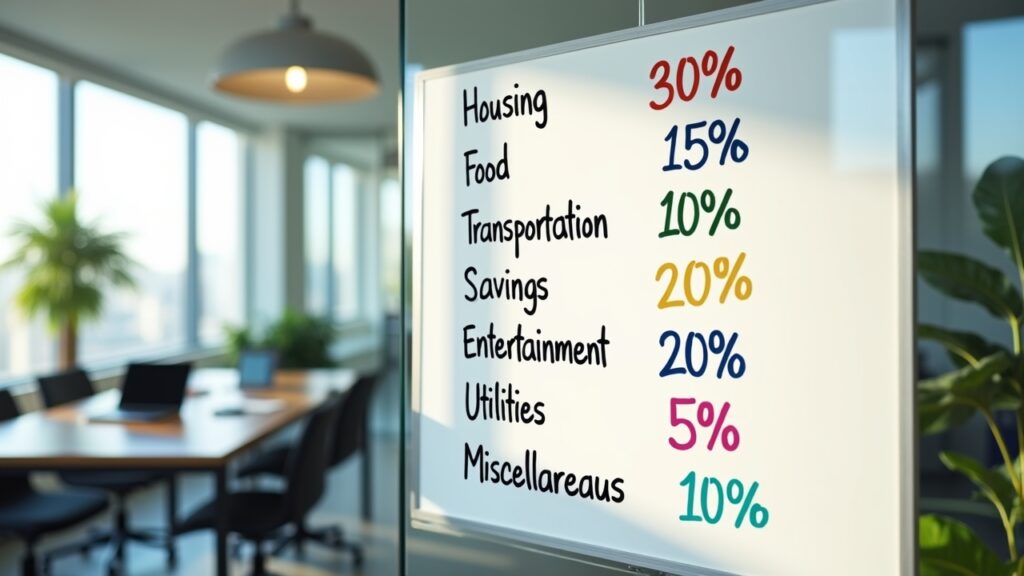Advertisements
Let me tell you, I used to be terrible with money. Like, checking my bank balance and crying terrible. It wasn’t until I discovered the magic of monthly budget categories that things finally clicked!
Did you know that the average American has over $90,000 in debt? Yeah, that stat made me feel a bit better about my own financial mess. But here’s the thing – organizing your spending into clear budget categories can literally change your life.
I’m gonna share exactly how I set up my monthly budget categories after years of trial and error. Trust me, if this recovering shopaholic can do it, so can you!
The Essential Budget Categories Everyone Needs

When I first started budgeting, I made things way too complicated. I had like 47 different categories and spent more time organizing than actually sticking to the budget. Big mistake.
Here’s what I’ve learned works best for most people:
- Housing (25-35% of income) – This includes rent or mortgage, property taxes, and home insurance
- Transportation (10-15%) – Car payments, gas, insurance, and maintenance
- Food (10-15%) – Groceries and dining out
- Utilities (5-10%) – Electric, water, gas, internet, and phone
- Savings (10-20%) – Emergency fund and retirement
- Personal (5-10%) – Clothing, grooming, and fun money
These percentages are based on the popular 50/30/20 budget rule, but honestly? I tweaked mine until they felt right. You should too!
Breaking Down the Needs vs Wants
OK, so here’s where I messed up initially. I thought Netflix was a “need” because, hello, how else was I supposed to unwind after work? But separating true needs from wants was a game-changer for my financial planning.
Your needs are the non-negotiables:
– Shelter
– Basic food
– Transportation to work
– Insurance
– Minimum debt payments
Everything else? That’s a want, my friend. Even that fancy coffee I “needed” every morning. (Though I still budget for it because life’s too short for bad coffee!)
The Forgotten Budget Categories That Bite You Later
Man, nothing ruins your budget faster than those expenses you forgot about. I learned this the hard way when my car registration came due and I had zero dollars set aside.
Here are the sneaky categories people always forget:
- Annual expenses – Car registration, professional licenses, Amazon Prime membership
- Irregular maintenance – Oil changes, HVAC filters, dental cleanings
- Gifts and holidays – Birthdays, Christmas, weddings (why does everyone get married in the same year?!)
- Medical expenses – Co-pays, prescriptions, and that random ER visit
Pro tip: Add up all your annual expenses and divide by 12. Set that amount aside each month. Your future self will thank you!
Creating Your Personal Spending Plan
Alright, let’s get into the nitty-gritty of setting up your own categories. First thing – grab your last three months of bank statements. I know, I know, it’s painful to look at.
Write down every single expense and group them into categories. Don’t judge yourself yet – just observe. When I did this, I discovered I was spending $300 a month on takeout. Oops.
Next, use a budgeting app like Mint or even a simple spreadsheet. I started with a notebook because I’m old school like that. Whatever works for you is the best system!
Customizing Categories for Your Lifestyle
Here’s where budgeting gets fun (yes, really!). Your budget should reflect YOUR life, not some generic template. Got pets? Add a pet category. Love traveling? Make it a priority.
My personal budget includes:
– A “plant addiction” category (don’t judge)
– Date night fund
– Home improvement savings
– Side hustle expenses
The key is being honest about what matters to you. If you love getting your nails done, budget for it! Just make sure your needs are covered first.
Your Budget, Your Rules

Look, creating monthly budget categories isn’t about restricting yourself – it’s about giving yourself permission to spend on what matters. Once I understood this, everything changed.
Start simple with the basic categories I mentioned. Track your spending for a month without judging. Then adjust your categories based on your actual life, not some ideal version of it.
Remember, the best budget is one you’ll actually stick to. It took me six tries to find a system that worked, and yours might take some tweaking too. That’s totally normal!
Ready to dive deeper into managing your money? Check out more budgeting tips and financial wisdom at Cashflow Zen – we’ve got tons of articles to help you master your finances without the boring financial jargon!




[…] to take control of your finances? Check out more money-saving tips and financial wisdom at Cashflow Zen – we’ve got tons of articles to help you build […]